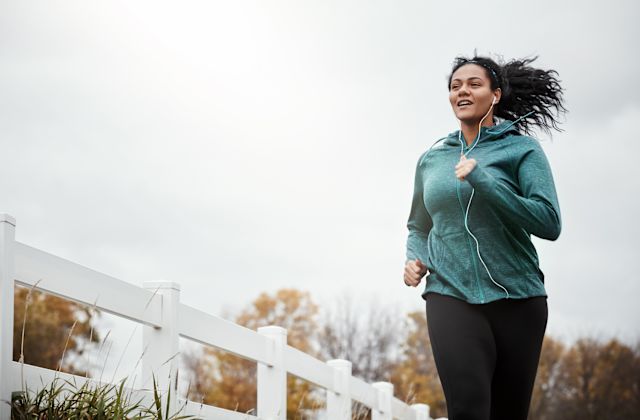Updated on October 10, 2024.
You probably have heard about some of the benefits of regular exercise, such as a healthier heart and an improved mood. But if you’re looking for more reasons to get moving, here’s another perk to add to the list: Engaging in as little as 25 minutes of physical activity a day can help lower your risk for breast cancer.
A little exercise goes a long way
Evidence suggests that regular, moderate-to-vigorous exercise may reduce the odds of developing breast cancer. The effect is even stronger in post-menopausal people. While the ideal amount of physical activity isn’t yet clear, just a few hours per week may have an effect.
The American Cancer Society recommends that adults get 150 to 300 minutes of moderate-intensity exercise each week. If you can swing it, more than 300 minutes is even better. Alternatively, you can do 75 to 150 minutes of vigorous activity. Moderate activity is comparable to a brisk walk, while vigorous activity is more intense and causes sweating and faster breathing.
Experts continue to investigate exactly how exercise helps to decrease breast cancer risk, but it’s believed to positively affect your weight, hormone levels, and inflammation, all of which likely contribute.
Limit sitting time
First and foremost, it’s important to limit the time you spend sitting, and to get up and move around as much as possible. The more a person sits, the higher their risk for developing breast cancer, alongside many other medical conditions such as obesity, cardiovascular disease, and type 2 diabetes.
But in this age of bingeing TV shows and working on a computer all day, how can we avoid sitting? The answer: Intentionally seek opportunities for movement. At the office, for example, you can:
- Take frequent breaks to stretch or walk.
- If you need to communicate with a colleague, walk over to them rather than calling or messaging them.
- Invest in a standing desk if possible.
- Whenever feasible, take stairs instead of an elevator or escalator.
When you’re not at work, try to engage in leisure activities that don’t involve sitting—like dancing with friends, joining a sports team, or going on active vacations.
Build a regular routine
Whether it’s a leisurely morning swim or a lunchtime jog, schedule regular movement. If your established routine gets boring after a while, switch up your workout. Join different classes at your local gym, enlist a trainer if possible, or stay accountable with a workout buddy. No matter which avenue you choose, aim to stay consistently active.
Get creative
Walking can do wonders. Running is an excellent workout. And cycling is one of the best aerobic exercises for your body, especially if you’re new to fitness. It's convenient, easy to do both indoors and out, and ideal if you’re looking for an activity that’s easy on the joints.
But moderate-intensity activities aren’t limited to just walking, and vigorous activities can be way more diverse than running or cycling. Some other great moderate-intensity activities include:
- Yoga
- Golf
- Gardening
- Yardwork
- Roller skating
- Softball
Vigorous intensity activities include:
- Fast biking
- Swimming
- Soccer
- Basketball
Physical activity has been linked to a lower risk of many other types of cancers, as well, so the benefits of being active are wide-ranging. Think about what activities you’d enjoy—and have a good time.







